|
Mariinsky Theatre |
|
|||||||||
|
In this issue of our monthly
|
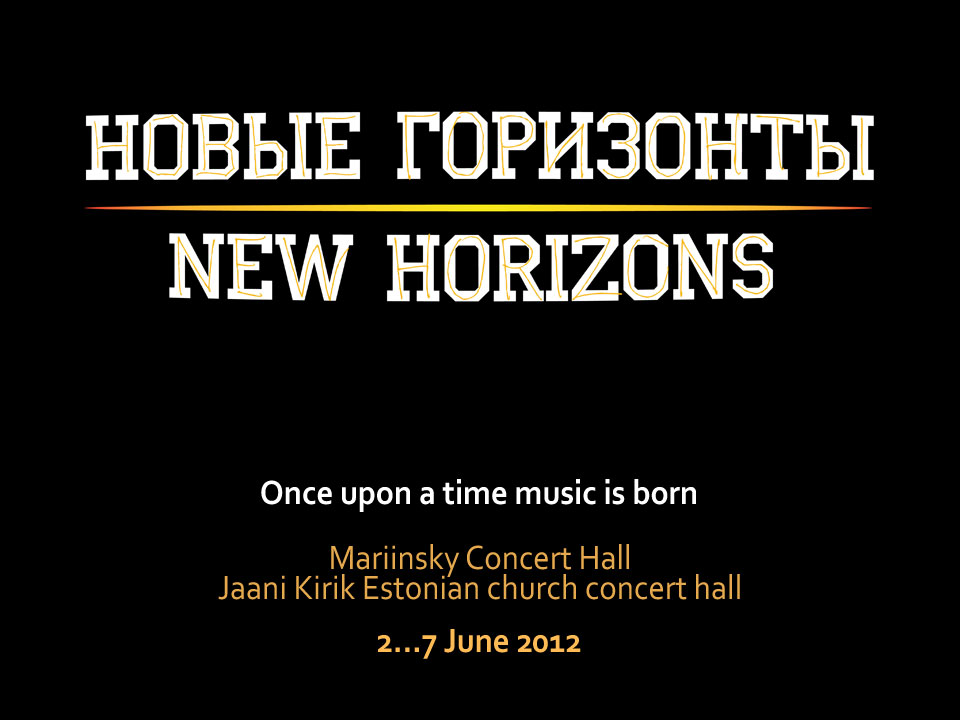
Life and death, eternity in harmony with nature: there is never anything really new...
Thierry Escaich: The concert promises to be very colourful and rhythmic. The programming of the concert evening has been arranged very well. In a way, a concert programme is a kind of composition too, don’t you think?
Interview with Thierry Escaich.
| Mariinsky Concert Hall | |
| Opening of the New Horizons Contemporary Music Festival | |
| Works by Mussorgsky, Shostakovich, Raskatov, Escaich, Dutilleux | |
|
Thierry Escaich (organ) Yekaterina Goncharova (soprano) Sergei Semishkur (tenor) Mariinsky Theatre Symphony Orchestra Conductor: Valery Gergiev | |
| 2 June, Saturday, 8:00PM | |
| Learn more | about this concert |
| Tickets | on the Mariinsky |
Knaifel, Silvestrov, Kancheli, Wagner, Raskatov, Khlebnikov and one big surprise: an experience one will remember for a long time to come.
Andres Mustonen: Audiences will experience the noble, sublime and intimate touch of another transcendental world. At this concert, everybody who comes with an open heart will feel it.
Interview with Andres Mustonen.
| Mariinsky Concert Hall | |
| Stairway to Heaven | |
| Works by Wagner, Silvestrov, Kancheli, Raskatov, Knaifel | |
|
Oleg Sychov (bass) Mariinsky Theatre Symphony Orchestra Conductor: Andres Mustonen | |
| 3 June, Sunday, 8:00PM | |
| Learn more | about this concert |
| Tickets | on the Mariinsky |
Andrei Korobeinikov, a Scriabin interpreter par excellence, puts contemporary music in search of a musical Utopia of the present day.
Andrei Korobeinikov: Scriabin is perhaps the most cosmogenic composer in the entire history of music. ... At the same time, if you fully immerse yourself in this music (and that is the only way to listen to it properly) you will sense the knowledge and energy with which Scriabin instils his music; the fire is incredibly truthful, veracious, definitely not just “fantasy.”
Interview with Andrei Korobeinikov.
| Mariinsky Concert Hall | |
| Utopia. Scriabin plus… | |
| Works by Scriabin, Raskatov, Frankstein, Shmurak, Ellin, Korobeinikov | |
|
Elena Vasilieva (soprano) Andrei Korobeinikov (piano) | |
| 4 June, Monday, 8:00PM | |
| Learn more | about this concert |
| Tickets | on the Mariinsky |
Americans show why RHYTHM was invented in the USA.
The eclectic programme selected to sample this innovative period will include works by Feldman, Babbitt, Crawford Seeger, Wuorinen, Sessions and Stravinsky. In the decades after WWII, the New York music scene witnessed a veritable explosion of new composition ideas, activities and personalities. Performers and audiences eagerly faced new technical and aesthetic challenges, and there was an engaged and enthusiastic reception for “new music,” allowing it to burgeon despite the sceptical or downright negative reaction from some members of the music world. This programme represents some of the luminaries of that period. They all knew and interacted with each other — sometimes as close friends, sometimes as barely tolerant colleagues.
Interview with concert performers.
| Jaani Kirik Eastonian church concert hall | |
| Americana | |
| Works by Cage, Babbitt, Helps, Davidovsky, Feldman, Seeger, Stravinsky, Sessions, Wuorinen | |
|
Alan Feinberg (piano) Aaron Boyd (violin) Jesse Mills (violin) Nicholas Cords (viola) Fred Sherry (cello) | |
| 5 June, Tuesday, 8:00PM | |
| Learn more | about this concert |
| Tickets | on the Mariinsky |
New musical horizons in this showcase of courage: “new” music and the Master — Johann Sebastian Bach.
Alexander Ivashkin: This will be a unique concert with four very different cellists performing. Each will be offering his own different views and concepts on Bach and modern music. You rarely have four soloists playing the same instrument and a living composer on same stage on the same night!
Interview with concert performers.
| Jaani Kirik Eastonian church concert hall | |
| Bach plus… The Three Celli | |
| Works by Bach, Raskatov, Vasks, Knaifel, Ligeti | |
|
Sergei Roldugin (cello) Alexander Ivashkin (cello) Ivan Monighetti (cello) Gavriel Lipkind (cello) Alexander Raskatov (piano) | |
| 6 June, Wednesday, 8:00PM | |
| Learn more | about this concert |
| SOLD OUT | |
The three cellists are each performing their favourite concerto before together surfing the waves on the ocean of Raskatov’s music: a world premiere! And all of this together with Valery Gergiev and musicians of the Mariinsky Theatre Orchestra...
Alexander Ivashkin: It is extremely exciting to have an opportunity to work with Valery Gergiev and the Mariinsky Theatre Orchestra, it’s great as he’s one of the greatest conductors in the world and it is one of the greatest orchestras. Their recent performance of Wagner’s Parsifal at London’s Barbican left me completely spellbound.
Interview with concert performers.
| Mariinsky Concert Hall | |
| Three celli plus… | |
| Works by Lutosławski, Tüür, Korndorf, Raskatov, Tishchenko | |
|
Gavriel Lipkind (cello) Alexander Ivashkin (cello) Ivan Monighetti (cello) Mariinsky Theatre Symphony Orchestra Conductor: Valery Gergiev | |
| 7 June, Thursday, 8:00PM | |
| Learn more | about this concert |
| Tickets | on the Mariinsky |
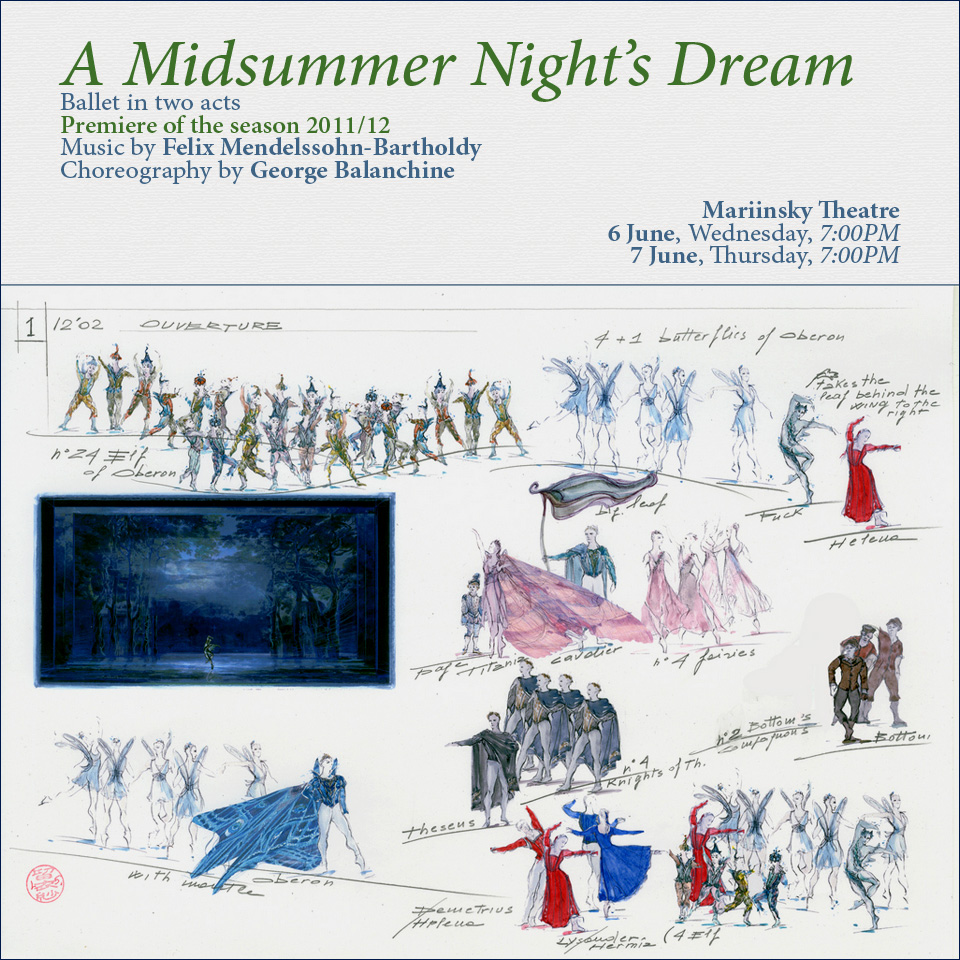
Pictures by Luisa Spinatelli
The Mariinsky Ballet will perform George Balanchine’s A Midsummer Night’s Dream, the main ballet premiere of the 20th Stars of the White Nights Music Festival and the 2011/12 season, on Wednesday June 6 and Thursday June 7. The ballet is based on William Shakespeare’s play and set to music by Felix Mendelssohn.
This is one of Balanchine’s few story ballets — most of his work is abstract — and has a fantastic fairytale atmosphere. Though the ballet was choreographed at the height of Balanchine’s American period, when he enjoyed international recognition, it is based on his childhood memories of the St Petersburg Imperial Theatre School and the Imperial Mariinsky Theatre. A Midsummer Night’s Dream was first performed in 1962 by the New York City Ballet. It was Balanchine’s first major ballet production in the United States. Balanchine constructed his ballet on the principles of neoclassical choreography, demonstrating how they could be used in a story ballet.
Sandra Jennings, a former dancer with the New York City Ballet, is a choreographer who coaches various ballet companies around the world on the Balanchine method. She has worked on this production with the Mariinsky Ballet. Costumes for the cast of elves, fairies, queens and kings have been designed by Luisa Spinatelli and the Mariinsky Theatre’s production team.
| Mariinsky Theatre Premiere of the season 2011/12 | |
| Mendelssohn A Midsummer Night’s Dream | |
|
Ballet in two acts Choreography by George Balanchine (1962) | |
| 6 June, Wednesday, 7:00PM | |
| Learn more | about this performance |
| Tickets | on the Mariinsky |
| 7 June, Thursday, 7:00PM | |
| Learn more | about this performance |
| Tickets | on the Mariinsky |
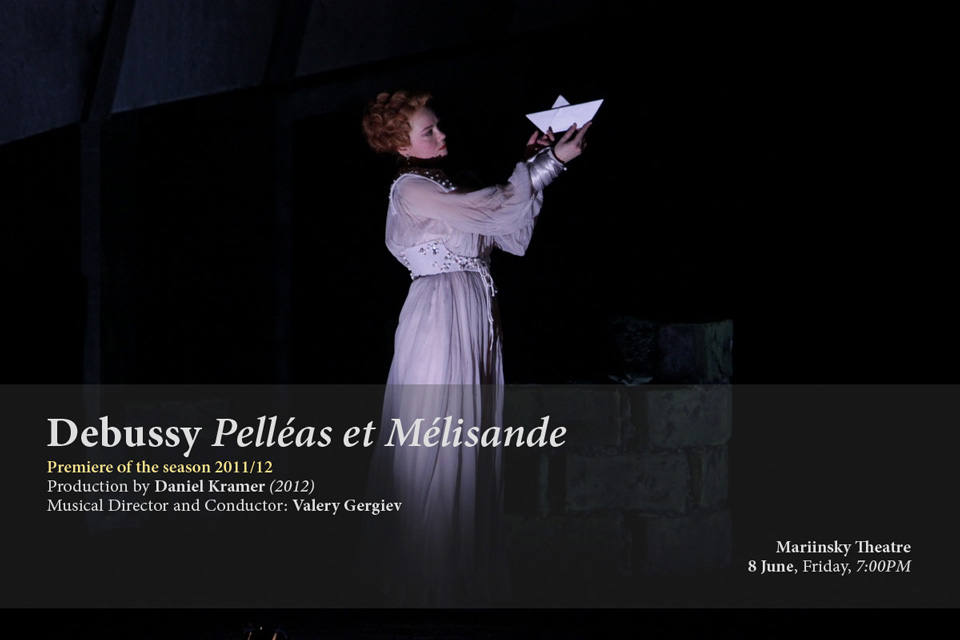
Photo: © Mariinsky Theatre | Natasha Razina
Friday June 8 will see a performance of Claude Debussy’s opera Pelléas et Mélisande in a production by Daniel Kramer that received its premiere at the Mariinsky Theatre in April. The story of a mournful love between Pelléas and Mélisande and sufferings of a jealous Prince Golaud is expressed by the composer with an amazing poetic beauty. The lack of external drama and acute conflict (as deliberately set by the author) is compensated by the poetic expression of mood and colour, mainly crepuscular, which shines only in the scenes that focus on the theme of love. There are no arias or ensembles as such in the opera, which, by means of music, explains a symbolist Maeterlinck’s drama (with minor cuts used as the basis for the opera). The music rather flows like a continuous stream. The work had made a great impact on the world of music, influencing the evolvement of new means of expression. Main ideas of the story, its style and characters are contrasted with those of Wagner’s musical drama, specifically, Tristan und Isolde with a typical for this opera emphatic expression and climax. External action in Pelléas et Mélisande is rather minor. Everything that happens on stage is performed as if at the depth of the characters’ souls, and only the echoes of the internal processes are receiving their external expression. The performance on June 8 will be conducted by Valery Gergiev.
| Mariinsky Theatre Premiere of the season 2011/12 | |
| Debussy Pelléas et Mélisande | |
|
Lyric drama in five acts Stage Production by Daniel Kramer (2012) Musical Director and Conductor: Valery Gergiev | |
| 8 June, Friday, 7:00PM | |
| Learn more | about this performance |
| Tickets | on the Mariinsky |
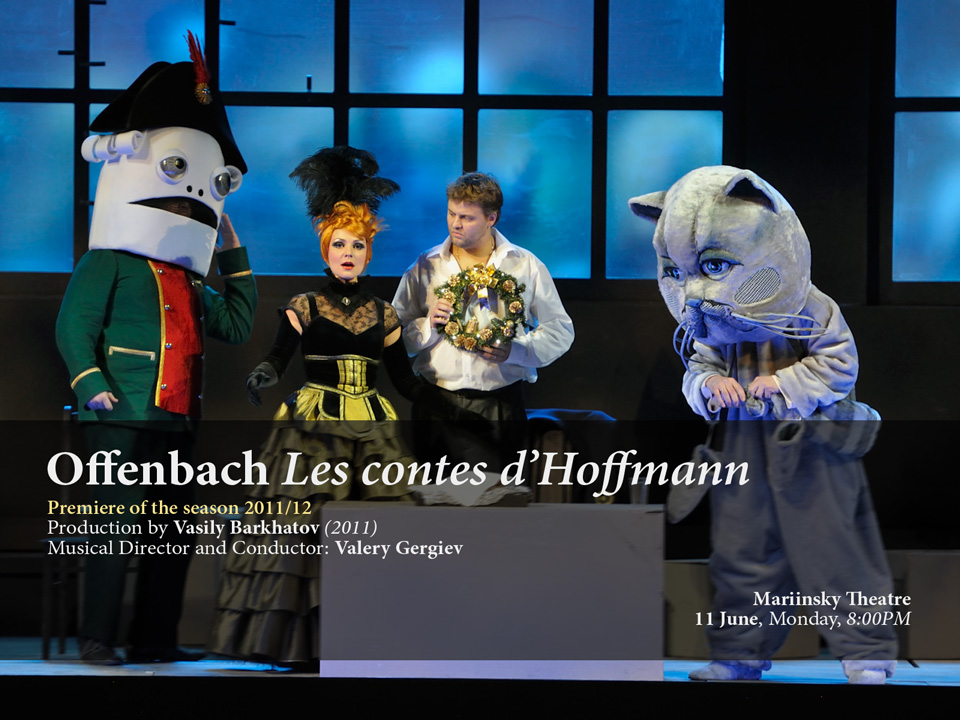
Photo: © Mariinsky Theatre | Valentin Baranovsky
Monday June 11 will see a performance of Jaques Offenbach’s opera Les contes d’Hoffmann in a production by Vasily Barkhatov that received its premiere at at the Mariinsky Theatre in December last year. The opera, which libretto is based of three novels by a talented German writer, lawyer, composer, literary critic and cartoonist Ernst Theodor Wilhelm Hoffmann (he changed his third name to Amadeus because of his passionate admiration of Mozart’s works), tells of three love stories that happened with the main character. In these stories, the young hero is turned into Hoffmann himself and therefore the name of the opera is a kind of a pun: Tales of Hoffmann are really tales by/about him, both because of their author is Hoffman, and because of they tell about Hoffman. The opera tells of the hero’s unrequited love for the singer Stella, who appears in his novels in the images of Olympia, Antonia and Giulietta that represent multiple facets of a Woman. The real and the imaginary world intertwine in the hero’s mind, thus forcing him to refuse his feelings.
According to Vasily Barkhatov, Les contes d’Hoffmann is “a drama of a man who conjures up a dream,
gives it a woman’s name and becomes lost in painful reveries. Hoffmann becomes transformed from an impressionable artist into the most ordinary
of men — not free, it is true, to cross the border between his own imagination and reality. The protagonist, experiencing the drama of love
and grasping the fact that he is not Jimi Hendrix, so to speak, becomes a
Les contes d’Hoffmann is not the first work produced by the team of director Vasily Barkhatov, stage designer Zinovy Margolin and costume designer Maria Danilova at the Mariinsky Theatre: they had previously worked on such opera productions as Jenůfa by Leoš Janáček, The Brothers Karamazov by Alexander Smelkov and Dead Souls by Rodion Shchedrin. The performance on June 11 will be conducted by Valery Gergiev, and, like in the December premiere, the part of Hoffmann will be sung by a tenor Sergei Semishkur whilst a bass Ildar Abdrazakov will perform roles of Lindorf, Coppélius, Dr. Miracle and Dapertutto.
| Mariinsky Theatre Premiere of the season 2011/12 | |
| Offenbach Les contes d’Hoffmann | |
|
Opéra fantastique in five acts Stage Production by Vasily Barkhatov (2011) Musical Director and Conductor: Valery Gergiev | |
| 11 June, Monday, 8:00PM | |
| Learn more | about this performance |
| Tickets | on the Mariinsky |
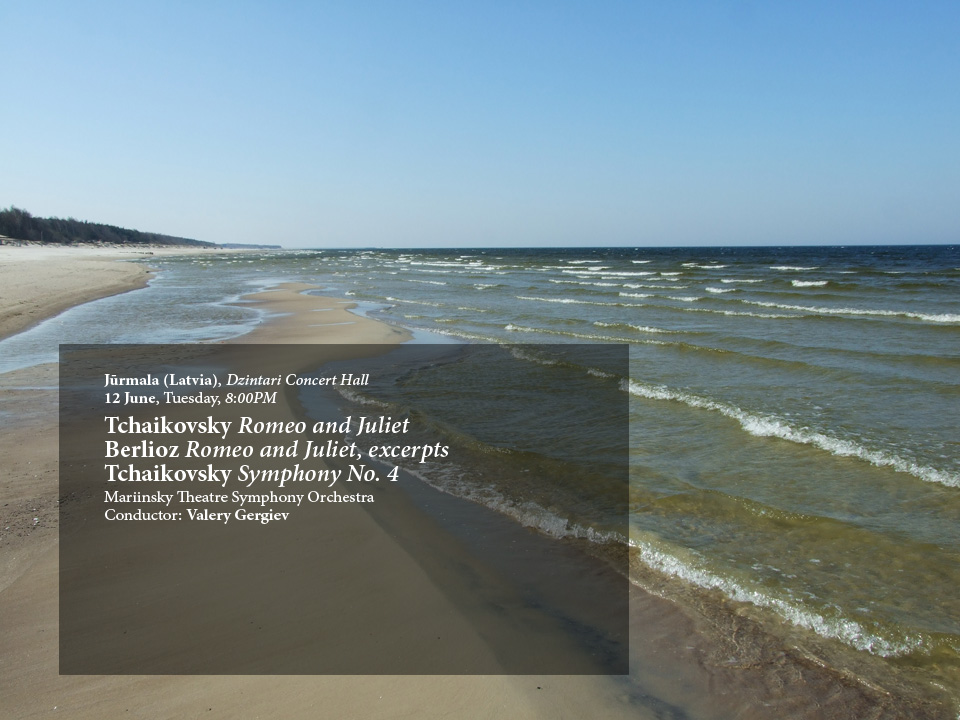
Photo: © Vytauto
On Tuesday June 12, the Mariinsky Theatre Symphony Orchestra and Valery Gergiev will perform in Jūrmala (Latvia) at the Dzintari Concert Hall. The concert will feature Tchaikovsky’s overture-fantasy Romeo and Juliet and Symphony No. 4 as well as excerpts from Berlioz’s symphonie dramatique Roméo et Juliette.
| Jūrmala (Latvia), Dzintari Concert Hall | |
| Tchaikovsky Romeo and Juliet, Berlioz Excerpts from Roméo et Juliette, symphonie dramatique Tchaikovsky Symphony No. 4 | |
|
Mariinsky Theatre Symphony Orchestra Conductor: Valery Gergiev | |
| 12 June, Tuesday, 8:00PM | |
| Learn more | about this concert |
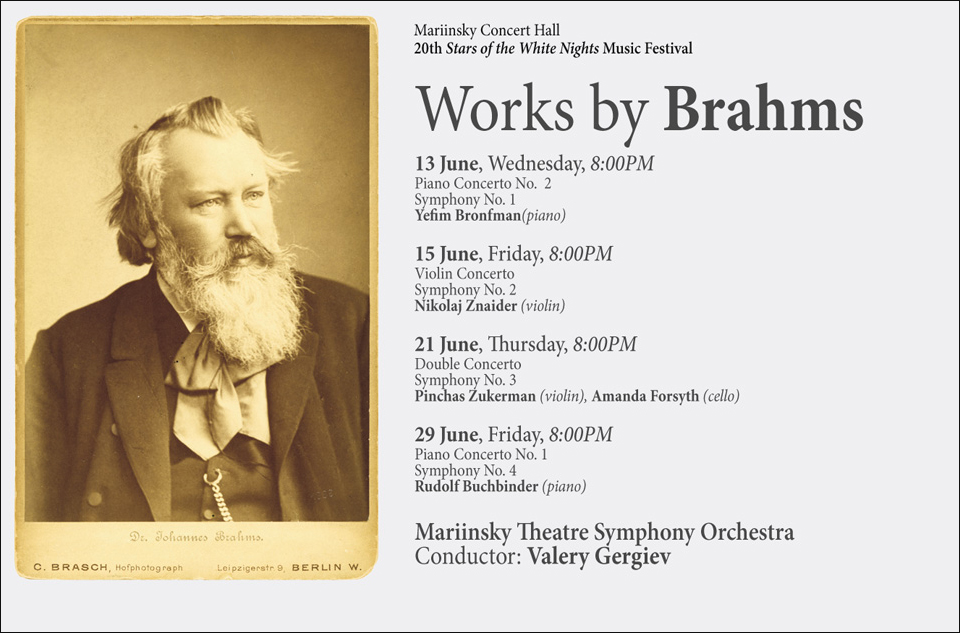
Four evenings at the 20th Stars of the White Nights Music Festival — June 13, 15, 21 & 29, will see the complete cycle of instrumental concertos and symphonies by Johannes Brahms. They will be performed by the Mariinsky Theatre Symphony Orchestra conducted by Valery Gergiev along with the following famous soloists: pianists Yefim Bronfman and Rudolf Buchbinder, violinists Nikolaj Znaider and Pinchas Zukerman, and cellist Amanda Forsyth. The complete Brahms cycle will be performed at the Mariinsky Concert Hall for the first time, joining a collection of symphonic cycles by Beethoven, Mahler, Tchaikovsky, Shostakovich and Schumann that have previously been performed in the hall.
The stature of Brahms among classical composers is well illustrated by his inclusion among the ‘Three Bs’ triumvirate of Bach, Beethoven, and Brahms. Of all the major composers of the late Romantic era, Brahms was the one most attached to the Classical ideal as manifested in the music of Haydn, Mozart, and especially Beethoven. Brahms’ symphonies, choral and vocal works, chamber music, and piano pieces are imbued with strong emotional feeling, yet take shape according to a thoroughly considered structural plan. In every genre in which he composed, Brahms produced works that have become staples of the repertory. The four symphonies — with lush scores, grand in scope, and deeply expressive — are cornerstones of the symphonic literature. Brahms’ concertos are, similarly, in a monumental, quasi-symphonic vein, calling for soloists with both considerable technical skill and stamina.
Symphonies brought Brahms true glory, reflecting various aspects of his perception of the world. In the First, once characterised by Hans von Bülow as ‘Beethoven’s Tenth,’ the crisis of dramatic collisions is successfully resolved in the joyful hymnic finale. The Second Symphony, a true Viennese work (reflecting the style of Haydn and Schubert), could justly be called a ‘symphony of joy.’ The Third — the most romantic in the whole cycle — reflects a journey from the incredible joy of life to grim anxiety and drama, a sudden retreat before the eternal beauty of nature. In the Fourth Symphony — the crowning glory of Brahms’ cycle — the depth of his scholarship was probably never more so evident than in this piece. The large scale of Brahms’ masterpieces does not exclude the deep lyricism inherent in all of his symphonies, which is effectively the ‘principal tonality’ of his music.
| Mariinsky Concert Hall As part of the 20th Stars of the White Nights Music Festival | |
| Works by Johannes Brahms | |
| Piano Concerto No. 2 Symphony No. 1 | |
| Soloist: Yefim Bronfman (piano) | |
| 13 June, Wednesday, 8:00PM | |
| Learn more | about this concert |
| Tickets | on the Mariinsky |
| Violin Concerto Symphony No. 2 | |
| Soloist: Nikolaj Znaider (violin) | |
| 15 June, Friday, 8:00PM | |
| Learn more | about this concert |
| Tickets | on the Mariinsky |
| Double Concerto for Violin, Cello and Orchestra Symphony No. 3 | |
| Soloists: Pinchas Zukerman (violin), Amanda Forsyth (cello) | |
| 21 June, Thursday, 8:00PM | |
| Learn more | about this concert |
| Tickets | on the Mariinsky |
| Piano Concerto No. 1 Symphony No. 4 | |
| Soloist: Rudolf Buchbinder (piano) | |
| 29 June, Friday, 8:00PM | |
| Learn more | about this concert |
| Tickets | on the Mariinsky |
| Mariinsky Theatre Symphony Orchestra Conductor: Valery Gergiev | |
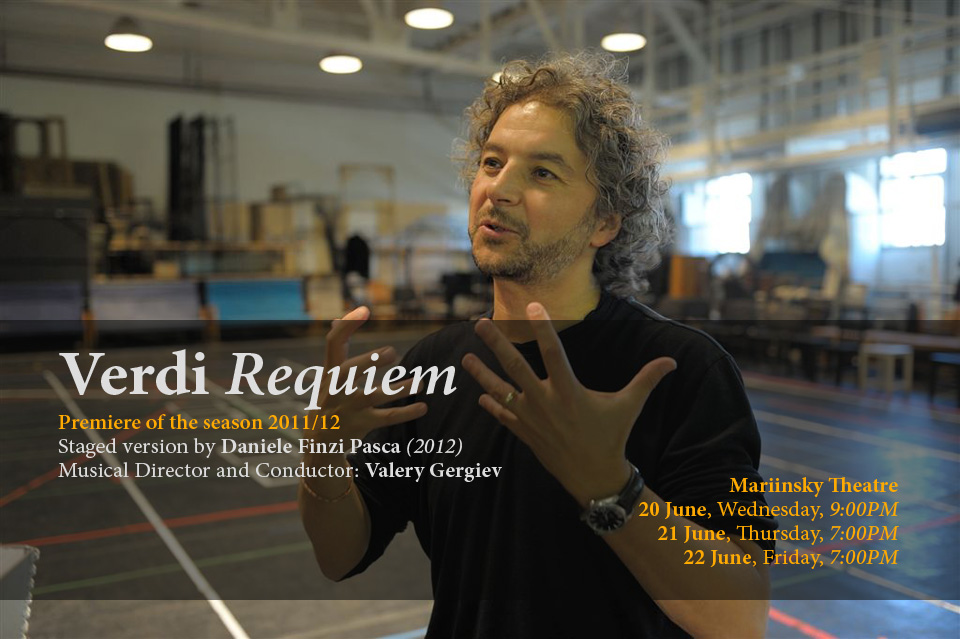
Photo: © Mariinsky Theatre | Valentin Baranovsky
Verdi’s Requiem will be performed on June 20, 21 & 22 at the Mariinsky Theatre. This is the premiere of a staged performance directed by Daniele Finzi Pasca. Valery Gergiev will conduct a cast that will include the Mariinsky Opera Soloists, Chorus and Orchestra.
This will be the first production created by Daniele Finzi Pasca for the historic stage of the Mariinsky Theatre, although he has previously worked with the theatre. He created a new production of Verdi’s Aida for the Mariinsky Concert Hall last year (which has been performed twenty times to date). His production of Leoncavallo’s I pagliacci was presented by the Teatro di San Carlo of Naples at the Mariinsky Theatre in October 2011.
Verdi’s Messa da Requiem is probably the most theatrical incarnation of the traditional Roman Catholic funeral mass. Few pieces in the repertoire offer the drama of opera and the thrill of wonderful symphonic writing combined with stellar, virtuosic solo moments. Verdi’s Requiem does all that and more.
| Mariinsky Theatre Premiere of the season 2011/12 | |
| Verdi Requiem | |
|
Production Concept by Daniele Finzi Pasca (2012) Mariinsky Theatre Opera Soloists, Chorus and Symphony Orchestra Musical Director and Conductor: Valery Gergiev | |
| 20 June, Wednesday, 9:00PM | |
| Learn more | about this performance |
| Tickets | on the Mariinsky |
| 21 June, Thursday, 7:00PM | |
| Learn more | about this performance |
| Tickets | on the Mariinsky |
| 22 June, Friday, 7:00PM | |
| Learn more | about this performance |
| Tickets | on the Mariinsky |
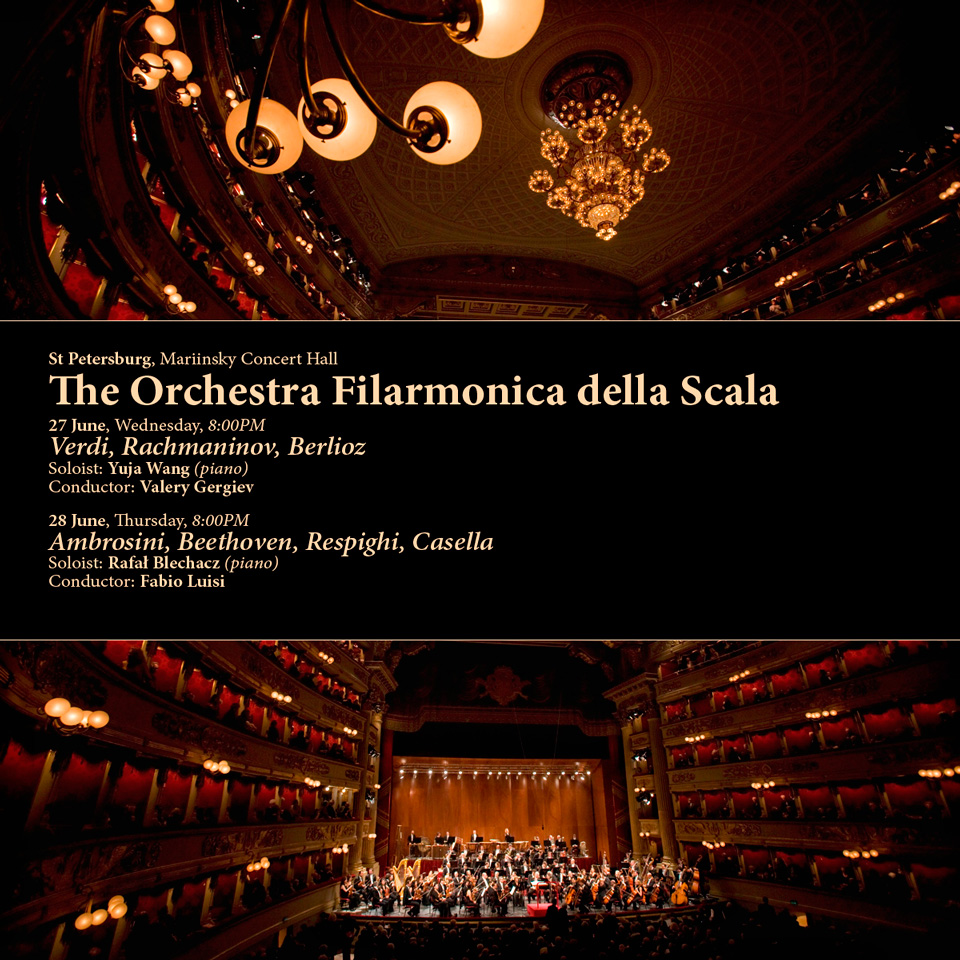
Photo: © Filarnonica della Scala | Silvia Lelli
The Orchestra Filarmonica della Scala from Milan will be playing on tour in St Petersburg, at the Mariinsky Concert Hall, on Wednesday June 27 and Thursday June 28. The Orchestra was established by Claudio Abbado and the musicians of the Teatro alla Scala in 1982 with the objective of enriching the Theatre’s glorious opera traditions with a repertoire of symphony music. The following year, the Filarmonica formed a separate Association. Under the management of Riccardo Muti, who served as the Principal Conductor from 1987 to 2005, the orchestra grew exponentially in artistic terms, establishing itself as a regular visitor to some of the world’s most prestigious concert halls. Over the past decade, the Orchestra Filarmonica della Scala has performed on tour on more occasions than any other Italian orchestra, introducing audiences throughout the world to the Italian performing traditions. The Orchestra actively promotes classical music among young people and organises rehearsals for schoolchildren before it opens each new season.
The Orchestra Filarmonica della Scala played in St Petersburg in 2000, at the 8th Stars of the White Nights Music Festival. That concert was conducted by Riccardo Muti at the Mariinsky Theatre and featured works by Verdi, Elgar and Schubert. This year, the musicians of the Filarmonica della Scala will perform under the baton of Valery Gergiev and Fabio Luisi, along with pianists Yuja Wang and Rafał Blechacz.
| Mariinsky Concert Hall As part of the 20th Stars of the White Nights Music Festival | |
| The Orchestra Filarmonica della Scala | |
| Verdi Overture to the opera La forza del destino Rachmaninov Piano Concerto No. 3 Berlioz Symphonie Fantastique | |
| Soloist: Yuja Wang (piano) Conductor: Valery Gergiev | |
| 27 June, Wednesday, 8:00PM | |
| Learn more | about this concert |
| Tickets | on the Mariinsky |
| Ambrosini Canzon No. 13, Canzon No. 1, Piano Sonata No. 19 Beethoven Piano Concerto No. 4 Casella Paganiniana, divertissement for orchestra on themes by Niccolò Paganini Respighi Feste romane, symphonic poem | |
| Soloist: Rafał Blechacz (piano) Conductor: Fabio Luisi | |
| 28 June, Thursday, 8:00PM | |
| Learn more | about this concert |
| Tickets | on the Mariinsky |
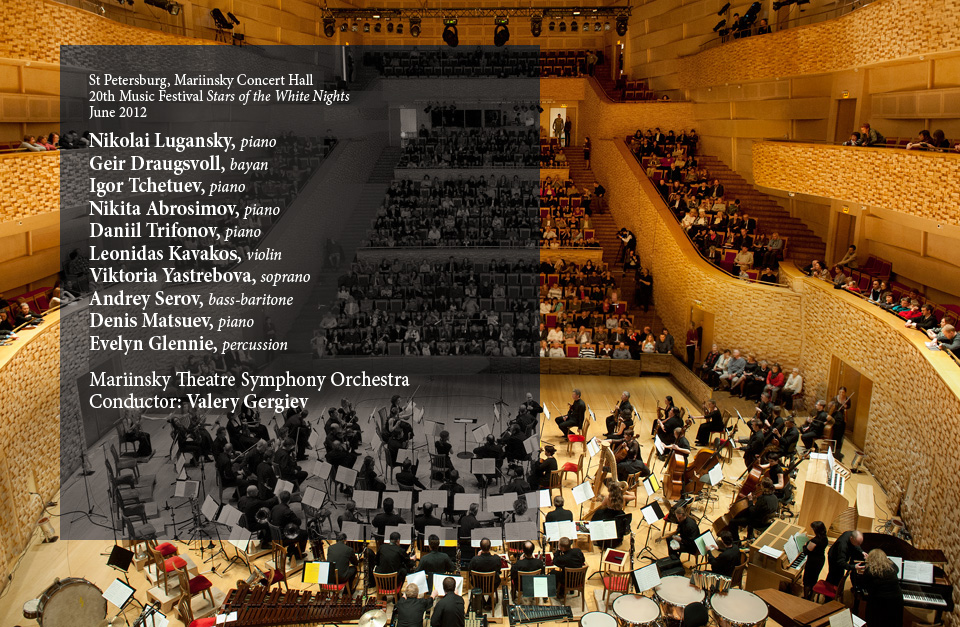
Photo: © Marie-Françoise Plissart
The Mariinsky Theatre Symphony Orchestra plays in virtually every single concert at the Stars of the White Nights Music Festival. Its musicians are probably the most hardworking in the entire Festival. This month the Orchestra will play a large number of concerts, which will be conducted by Valery Gergiev, the Festival’s founder and artistic director. On top of performing the complete cycle of Brahms symphonies and instrumental concertos at the Festival, and performing the Mariinsky Theatre’s current repertoire, the musicians will play a wide variety of works that will highlight different facets of their skills and professionalism, such as their ability to play works in different musical styles, playing in ensembles, performing solo, and much more. Together with the Orchestra, Valery Gergiev will partner a number of soloists, listening to and supporting them musically during concerts, whilst in a series of large-scale symphonic works he will enable the Orchestra to demonstrate its sheer power and its ability to bring audiences its rich, expressive sound. These concerts will all be held at the Mariinsky Concert Hall, famous for its perfect acoustics, which are a pleasure to every musician who plays there.
| Mariinsky Concert Hall As part of the 20th Stars of the White Nights Music Festival | |
| Lyadov Kikimora Rachmaninov Piano Concerto No. 3 Gubaidulina Fachwerk, Bayan Concerto Bartók Suite from music for the ballet The Miraculous Mandarin | |
| Soloists: Nikolai Lugansky (piano), Geir Draugsvoll (bayan) Mariinsky Theatre Symphony Orchestra Conductor: Valery Gergiev | |
| 5 June, Tuesday, 8:00PM | |
| Learn more | about this concert |
| Tickets | on the Mariinsky |
| Mariinsky Concert Hall As part of the 20th Stars of the White Nights Music Festival | |
| Lyadov Baba Yaga Scriabin Piano Concerto Shostakovich Symphony No. 7 (Leningrad) | |
| Soloist: Igor Tchetuev (piano) Mariinsky Theatre Symphony Orchestra Conductor: Valery Gergiev | |
| 6 June, Wednesday, 8:00PM | |
| Learn more | about this concert |
| Tickets | on the Mariinsky |
| Mariinsky Concert Hall As part of the 20th Stars of the White Nights Music Festival | |
| Lyadov The Enchanted Lake Lyadov From the Apocalypse Prokofiev Piano Concerto No. 2 Shostakovich Symphony No. 5 | |
| Soloist: Nikita Abrosimov (piano) Mariinsky Theatre Symphony Orchestra Conductor: Valery Gergiev | |
| 9 June, Saturday, 8:00PM | |
| Learn more | about this concert |
| Tickets | on the Mariinsky |
| Mariinsky Concert Hall As part of the 20th Stars of the White Nights Music Festival | |
| Shostakovich Symphony No. 12 Glazunov Piano Concerto No. 2 Shostakovich Symphony No. 5 | |
| Soloist: Daniil Trifonov (piano) Mariinsky Theatre Symphony Orchestra Conductor: Valery Gergiev | |
| 16 June, Saturday, 8:00PM | |
| Learn more | about this concert |
| Tickets | on the Mariinsky |
| Mariinsky Concert Hall As part of the 20th Stars of the White Nights Music Festival | |
| Messiaen L’Ascension, four symphonic meditations Prokofiev Violin Concerto No. 2 Prokofiev Piano Concerto No. 3 | |
| Soloists: Leonidas Kavakos (violin), Denis Matsuev (piano) Mariinsky Theatre Symphony Orchestra Conductor: Valery Gergiev | |
| 19 June, Tuesday, 8:00PM | |
| Learn more | about this concert |
| Tickets | on the Mariinsky |
| Mariinsky Concert Hall As part of the 20th Stars of the White Nights Music Festival | |
| Massenet Interlude from the opera Don Quichotte Massenet Sancho Pança’s aria from the opera Don Quichotte Richard Strauss Burleske for Piano and Orchestra Richard Strauss Vier Letzte Lieder for soprano and orchestra Liszt Piano Concerto No. 1 Richard Strauss Don Juan, symphonic poem | |
| Soloists: Viktoria Yastrebova (soprano), Andrei Serov Mariinsky Theatre Symphony Orchestra Conductor: Valery Gergiev | |
| 22 June, Friday, 10:00PM | |
| Learn more | about this concert |
| Tickets | on the Mariinsky |
| Mariinsky Concert Hall As part of the 20th Stars of the White Nights Music Festival | |
| Vivaldi Piccolo Concerto, arrangement for vibraphone, strings and harpsichord Áskell Másson Concert piece for snare drum and orchestra Jacob ter Veldhuis Barracuda Concerto Stravinsky Pétrouchka | |
| Soloist: Evelyn Glennie (percussion) Mariinsky Theatre Symphony Orchestra Conductor: Valery Gergiev | |
| 25 June, Monday, 8:00PM | |
| Learn more | about this concert |
| Tickets | on the Mariinsky |
|
Main information
Official |
Beyond the stage
|
Contact us
|